
| Palaeos |  |
Cetartiodactyla |
| Vertebrates | Selenodontia |
| Page Back | Unit Home | Unit Dendrogram | Unit References | Taxon Index | Page Next |
| Unit Back | Vertebrates Home | Vertebrate Dendrograms | Vertebrate References | Glossary | Unit Next |
|
Abbreviated Dendrogram
LAURASIATHERIA |--FERAE `--+--PERISSODACTYLA | CETARTIODACTYLA |--Cetacea | |--Pakicetidae | `--Autoceta `--Artiodactyla |--Suina | |--Hippopotamidae | `--Suoidea `--Selenodontia |--Helohyidae `--+--Anoplotheroidea `--+--Oreodontoidea `--+--Camelidae | |--Poebrotherium | `--+--Stenomylinae | `--+--Miolabinae | `--+--Protolabinae | `--Camelinae `--Ruminantia |--Giraffoidea `--+--Bovoidea `--Cervoidea |
Contents
Overview |
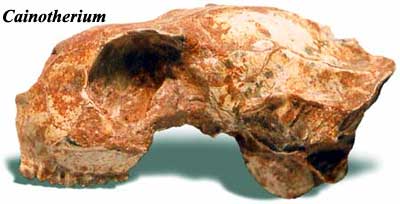 Anoplotheroidea
AnoplotheroideaLike the other "unpig" taxa, the Anoplotheroidea have been assembled by piecing together various traditional groups. In this case, we include Cainotherium (a/k/a Caenotherium), Dacrytherium and their respective allies, together with the Anoplotheriidae. The group as a whole is strongly convergent on the Camelidae, with whom they are grouped as basal selenodonts, or within Tylopoda [C88], or both [G01]. Note that the skull of Cainotherium here doesn't look much like a camelid. Our first naive reaction on seeing the skull of Cainotherium was that it looked like vegetarian house cat.
The clade seems to be suffused with phylogenetic odds and ends which developed odd specializations in temporary isolation on the Eocene islands of what is now Europe. ATW040724.
Image: Cainotherium skull from The Natural Canvas.
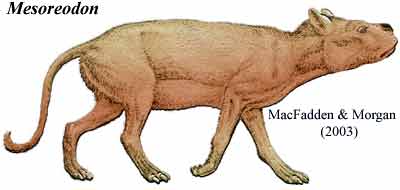 Oreodontoidea
OreodontoideaThe Oreodontoidea tend to look much alike. They are found only in North America, where they are extremely common. Thus, the Oreodontoidea appears to be a well-organized clade. Unfortunately, appearances can be deceiving. The similarities are largely shared primitive characters. They tend to have squarer skulls than other artiodactyls, and some developed vaguely tapir- or hippo-like adaptations. They never became runners or developed the high-crowned teeth of efficient grass-grazers. Other than this, they are united largely by being unspecialized in limb and dentition. Evolution within the group is getting reasonably well worked out, hampered only by the very generous diversity of the oreodontoids. However, their monophyly and origins are anyone's guess.
Image: Mesoreodon of the Late Oligocene of Florida. Adapted from [MM03].
Range: from the Late Eocene
Phylogeny: Artiodactyla :: Suina + * : Helohyidae + (Anoplotheroidea + (Oreodontoidea + (Camelidae + Ruminantia))).
Characters: postorbital bar complete; selenodont cheek teeth; incisors reduced or missing; cannon bone ( = fused metapodials); enlarged stomach divided into 3 or more chambers.
Links: Selenodontia (Mikko); artiodactyls. ATW030109.
Helohyidae: Achaenodon, Apriculus, Bunodentus, Gobiohyus, Helohyus, Ithygrammodon, Lophiohyus, Pakkokuhyus, Parahyus.
Range: Middle to Late Eocene of South Asia, Southeast Asia, China & North America
Phylogeny: Selenodontia : (Anoplotheroidea + (Oreodontoidea + ( Camelidae + Ruminantia))) + *
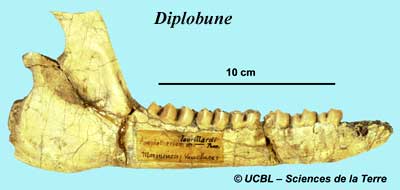 Anoplotheroidea:
Bunomeryx, Cainotherium, Dacrytherium, Oxacron.
Anoplotheroidea:
Bunomeryx, Cainotherium, Dacrytherium, Oxacron.
Range: Eocene to Pliocene.
Phylogeny: Selenodontia :: (Oreodontoidea + ( Camelidae + Ruminantia)) + *.
Characters: petrosal, inner surface with deep mastoid fossa; petrosal, ventral margin expanded; internal auditory meatus reduced.
Image: Diplobune jaw from Collection BRAIN.
References: Carroll (1988) [C88], Geisler (2001) [G01]. ATW040721.
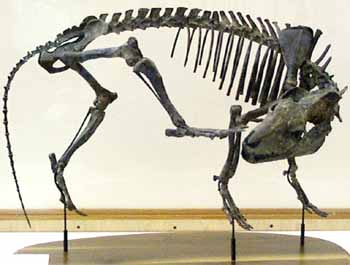 Oreodontoidea: may
be Tylopods [PS02]
Oreodontoidea: may
be Tylopods [PS02]
Range: Middle Eocene to Middle Miocene of North America [PS02].
Phylogeny: Selenodontia ::: (Camelidae + Ruminantia) + *.
Characters: cat to large pig-sized herbivores; teeth with selenodont dentition, but never high-crowned [PS02]; never specialized for running or for grass [PS02]
Image: Mesoreodon from the Florida Museum of Natural History.
Links: Oreodontoidea [Merycoidodontoidea] (Mikko); Untitled (Czech); Oreodont (skull image); SDNHM - Oreodont (Sespia californica) (photo and basic information); GEOCLASSICS - Oreodont (multiple large photos of skull from various angles); Teeth (MAM076); "Douglas fossils"oreodont, titanothere, Palaeolagus,Stylemys, ...; Fossil Hunting- NJPS Expedition West 2001.
References: Carroll (1986) [C88], MacFadden & Morgan (2003) [MM03], Prothero & Schoch (2002) [PS02]. ATW040724.
 Camelidae:
camels, llamas & vicuñas. Camelus, Lama, Vicugna.
Camelidae:
camels, llamas & vicuñas. Camelus, Lama, Vicugna.
Range: from the Late Eocene. Endemic to North America until the Pliocene. Extinct in North America at ~10ky.
Phylogeny: Selenodontia :::: Ruminantia + * : Poebrotherium + (Stenomylinae + (Miolabinae + (Protolabinae + Camelinae))).
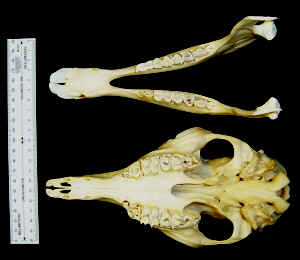 Characters:
large (35-650 kg); head small; parietal longer than frontal [WW05$]; sagittal crest well developed; postorbital
bar complete; no horns or antlers [WW05]; mastoid broadly exposed in posterolateral
region of cranium [WW05$];
"cancellous
auditory bulla composed of two ventrally extended plates
separated posterolaterally by a deep tympanohyal recess [1]" [WW05$];
"postglenoid process articulating anteriorly with facet of mandibular
condyle" [WW05$]; mandibular symphysis
solidly fused [WW05$]; cheek teeth selenodont; upper
incisors present (juveniles 3 pairs on each side & adults 1, canine-like);
lower incisors spatulate &
procumbent; upper & lower canines present,
medium-sized & hooked; wide diastema between incisors & cheek teeth;
first premolars simple & usually separated from the other cheek teeth;
molars with crescentic ridges of enamel on crowns; upper lip with deep cleft;
necks long & gracile; limbs long & slender; ulna and fibula are much
reduced, present mainly as a splint on the radius or tibia; ectocuneiform
fused to mesocuneiform
in the pes [WW05$]; navicular
and cuboid
not fused [WW05]; primitively with
fused cannon
bone; digits I, II & V absent; 3rd and 4th metapodials
proximally fused to form cannon bone, but the fusion is lost distally;
metapodials separate distally & and splay wide apart (only plantigrade or
fully digitigrade ungulates);
metapodials with distal keels on plantar
surfaces only [WW05]; first two phalanges of each digit flattened
expanded; second phalanges embedded in a broad pad that makes up the sole of the
foot; last phalanx reduced & with nail; distal
sesamoids cartilagenous, not ossified [WW05$]; complex 3-chambered,
ruminating
stomach; red blood corpuscles oval instead of circular & very numerous;
diurnal; herbivorous, feeding primarily on grasses; unique pacing
gait [J+02]; generally found in arid or
semi-arid areas.
Characters:
large (35-650 kg); head small; parietal longer than frontal [WW05$]; sagittal crest well developed; postorbital
bar complete; no horns or antlers [WW05]; mastoid broadly exposed in posterolateral
region of cranium [WW05$];
"cancellous
auditory bulla composed of two ventrally extended plates
separated posterolaterally by a deep tympanohyal recess [1]" [WW05$];
"postglenoid process articulating anteriorly with facet of mandibular
condyle" [WW05$]; mandibular symphysis
solidly fused [WW05$]; cheek teeth selenodont; upper
incisors present (juveniles 3 pairs on each side & adults 1, canine-like);
lower incisors spatulate &
procumbent; upper & lower canines present,
medium-sized & hooked; wide diastema between incisors & cheek teeth;
first premolars simple & usually separated from the other cheek teeth;
molars with crescentic ridges of enamel on crowns; upper lip with deep cleft;
necks long & gracile; limbs long & slender; ulna and fibula are much
reduced, present mainly as a splint on the radius or tibia; ectocuneiform
fused to mesocuneiform
in the pes [WW05$]; navicular
and cuboid
not fused [WW05]; primitively with
fused cannon
bone; digits I, II & V absent; 3rd and 4th metapodials
proximally fused to form cannon bone, but the fusion is lost distally;
metapodials separate distally & and splay wide apart (only plantigrade or
fully digitigrade ungulates);
metapodials with distal keels on plantar
surfaces only [WW05]; first two phalanges of each digit flattened
expanded; second phalanges embedded in a broad pad that makes up the sole of the
foot; last phalanx reduced & with nail; distal
sesamoids cartilagenous, not ossified [WW05$]; complex 3-chambered,
ruminating
stomach; red blood corpuscles oval instead of circular & very numerous;
diurnal; herbivorous, feeding primarily on grasses; unique pacing
gait [J+02]; generally found in arid or
semi-arid areas.
Image: (left) Lama from the University of Massachusetts Mammalogy Database
Notes: [1] "tympanohyal recess" is not a common anatomical term. Presumably, [WW05] mean the depression which can be seen to split each bulla into two parts in the image of the ventral skull above.
Links: Family Camelidae; Camelidae; Camelidae; Kamele (German); Camelidae; Evolución Molecular de la Fam. Camelidae; UMass Mammalogy Database Search Results.
References: Janis et al. (2002) [J+02], Whistler & Webb (2005) [WW05]. ATW051120.
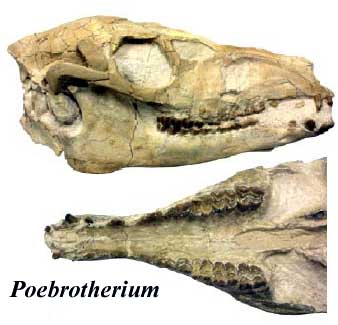 Poebrotherium:
P. wilsoni Leidy, 1847; P. chadronense Wilson, 1974; P.
eximitum; P. franki; P. labiatum
Poebrotherium:
P. wilsoni Leidy, 1847; P. chadronense Wilson, 1974; P.
eximitum; P. franki; P. labiatum
Range: Late Eocene to Late Oligocene of North America [J+02]
Phylogeny: Camelidae : (Stenomylinae + (Miolabinae + (Protolabinae + Camelinae))) + *.
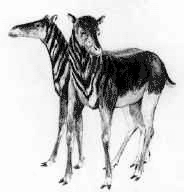 Characters:
~100 cm tall; long-necked [PS02]; unspecialized teeth; diastema weak, but
present [PS02]; neck long [WW05]; legs moderately long [J+02] [PS02]; pes
generally similar to ruminants [J+02]; digits 1, 4 & 5 absent; metapodials
not fused [J+02] (contra [PS02]); metapodial proximal surfaces wider than
deep [WW05]; metapodials long [J+02]; metapodials not splayed [J+02] [contra
[PS02]); unguligrade
foot posture [J+02]; but without foot pad [1].
Characters:
~100 cm tall; long-necked [PS02]; unspecialized teeth; diastema weak, but
present [PS02]; neck long [WW05]; legs moderately long [J+02] [PS02]; pes
generally similar to ruminants [J+02]; digits 1, 4 & 5 absent; metapodials
not fused [J+02] (contra [PS02]); metapodial proximal surfaces wider than
deep [WW05]; metapodials long [J+02]; metapodials not splayed [J+02] [contra
[PS02]); unguligrade
foot posture [J+02]; but without foot pad [1].
Notes: [1] In short, Poebrotherium lacked the limb specializations of either ruminants or modern camelids [J+02].
Links: HSU NHM Grasers Display Index (another good skull);
References: Janis et al. (2002) [J+02]; Prothero & Schoch (2002) [PS02]; Wall & Hauptman (2001); Whistler & Webb (2005) [WW05]. ATW051123.
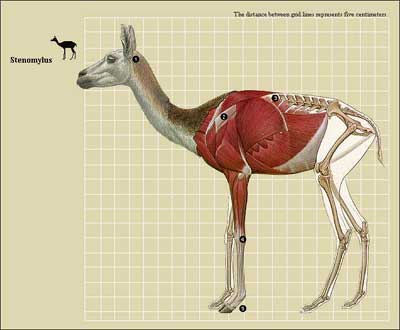 Stenomylinae:
Miotylopus, Pseudolabis, Stenomylus
Stenomylinae:
Miotylopus, Pseudolabis, Stenomylus
Range: Early Oligocene to Middle Miocene of North America
Phylogeny: Camelidae :: (Miolabinae + (Protolabinae + Camelinae)) + *.
Characters: premaxilla elongate, partially separating nasal & maxilla [WW05]; rostrum elongate [WW05]; closed orbit with postorbital bar very broad [WW05]; bullae somewhat transversely compressed [WW05]; dentary posterior mental foramen absent [WW05]; dentary angular process reduced or absent [WW05]; dentary coronoid process very short [WW05]; I1-2 enlarged "occluding in transverse arcade with lower incisors" [WW05]; premolars reduced and separated (incipient diastema) [WW05]; molar lengths increase strongly from front to back [WW05]; molars may be highly hypsodont [M+02]; mesostyle absent [WW05$]; ribs broad & flat [J+02]; coracoid process narrow, short, with medial concavity [WW05]; humeral head large and overhangs shaft [WW05]; acromion process not strongly developed [WW05]; ilac crest laterally expanded [J+02] (contra? [WW05]); lesser trochanter well-developed [WW05]; lateral calcaneum deeply concave [WW05]; metapodials medium to long [J+02]; metapodials at least partially fused [J+02] [WW05$]; metapodials slightly splayed [J+02]; probably unguligrade posture [J+02]
Image: from the USGS Northern Prairie Wildlife Research Center.
References: Janis et al. (2002) [J+02]; Mendoza et al. (2002) [M+02]; Whistler & Webb (2005) [WW05]. ATW051123.
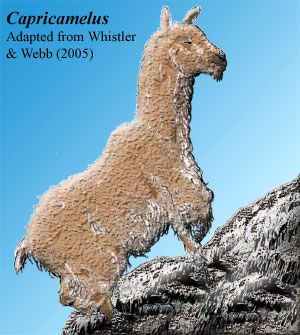 Miolabinae:
Capricamelus, Miolabis, Nothotylopus, Paramiolabis
Miolabinae:
Capricamelus, Miolabis, Nothotylopus, Paramiolabis
Range: Early Miocene to Late Pliocene of North America.
Phylogeny: Camelidae ::: (Protolabinae + Camelinae) + *.
Characters: premaxilla elongate, partially separating nasal & maxilla [WW05]; rostrum elongate, with maximum width across incisors [WW05$]; closed orbit with postorbital bar very broad [WW05]; bulla deep & transversely narrow [WW05$]; dentary posterior mental foramen absent [WW05]; dentary with much enlarged posteroventral apron [WW05]; dentary angular process strongly reduced or absent [WW05$]; dentary coronoid process very short [WW05$]; upper incisors enlarged [WW05]; I1-2 "occluding in transverse arcade with lower incisors" [WW05]; reduction of premolars [WW05]; parastyles reduced on P2 and P3 [WW05$]; trend to reduced hypsodonty [PS02]; cervical vertebrae short [WW05$]; metatarsals of moderate length [J+02] (contra [WW05]: metapodials short); metapodials unfused or partially fused [J+02]; digits unsplayed or slightly splayed [J+02];
References: Janis et al. (2002) [J+02]; Prothero & Schoch (2002) [PS02]; Whistler & Webb (2005) [WW05]. ATW051125
| Page Back | Unit Home | Page Top | Page Next |
checked ATW010826